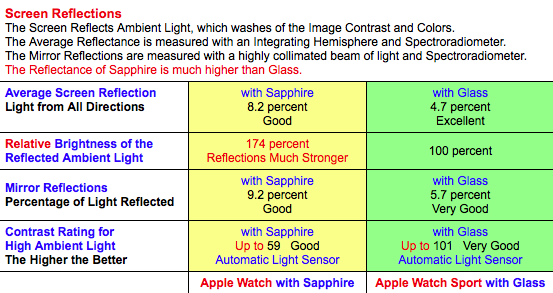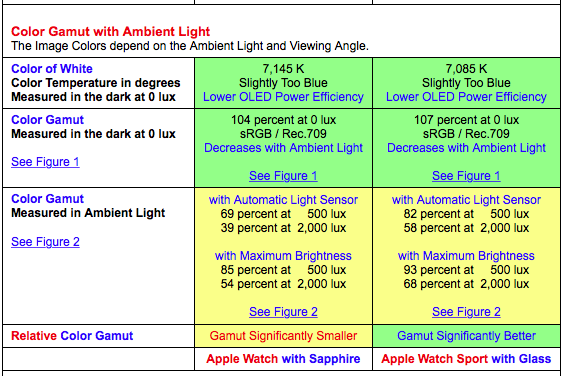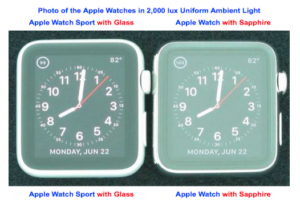Once again, in the pursuit of “state-of-the-art” displays, we are getting a peek with the DisplayMate Labs microscope into an Apple Watch display shoot-out. This time, founder Dr. Raymond Soneira, announced an in-depth review of the ambient light performance of Apple’s newest wearable device, that uses different types of display covers – sapphire and glass crystal.

The fundamental principles of optics favor glass over sapphire, according to Soneira, who tells us we get a 20% brightness boost if we skip the more expensive (yet harder) sapphire. But that’s only part of the story.
Two versions of the Apple Watch in moderate daylight settings. Source: DisplayMate Labs June 2015
First, Soneira tells us that both watches from Apple use identical OLED displays, with the only difference being the Ion-X glass and sapphire crystal (tested in the cheaper anodized aluminum case and the mirror stainless steel finish respectively.) He also points out the photometry and colorimetry calibration measurements of both glass and sapphire based watches were identical (at zero lux of ambient light), meeting the DisplayMate standard of “very good” to “excellent” in all metric that were tested. In short, Soneira said: “In the dark both Apple Watch displays appear and perform identically, but in ambient light they appear and perform differently due to the difference in the reflectance of sapphire and glass.”
 We think that’s a bit of an understatement, specifically, in a moderate outdoor light (2000 lux) the Apple Watch Sport with its anodized aluminum case measured a screen reflectance (lower is better) of 4.7%, versus 8.2% for the sapphire with mirror stainless steel finish case. That’s a whopping 74% higher reflectance for the harder sapphire material for use in one of the most common environs: moderate outdoor lighting in the shade or an overcast sky. For an example, see the image of both watches under these “moderate” light conditions, above. Soneira points out the sapphire watch, with its 74% higher reflectance, “…means that its screen will reflect almost twice as much surrounding ambient light [than the lower cost Sport version] …and it takes surprisingly little ambient light for that to make a visible difference,” he said.
We think that’s a bit of an understatement, specifically, in a moderate outdoor light (2000 lux) the Apple Watch Sport with its anodized aluminum case measured a screen reflectance (lower is better) of 4.7%, versus 8.2% for the sapphire with mirror stainless steel finish case. That’s a whopping 74% higher reflectance for the harder sapphire material for use in one of the most common environs: moderate outdoor lighting in the shade or an overcast sky. For an example, see the image of both watches under these “moderate” light conditions, above. Soneira points out the sapphire watch, with its 74% higher reflectance, “…means that its screen will reflect almost twice as much surrounding ambient light [than the lower cost Sport version] …and it takes surprisingly little ambient light for that to make a visible difference,” he said.
By the numbers, relative contrast and colour gamut (measured as a percentage, so higher is better) both take a hit on the bench measurements as well. For contrast, even when moving to 500 lux indoor lighting conditions, glass falls from infinite (measured for both displays at zero lux) to just 29%, and 17% for sapphire (with the auto light sensor engaged.) With no light sensor, and the OLED display producing full brightness (480 nits display output) the contrast in a 500 lux room environment jumps to 64% for the Ion-X glass and 38% for sapphire. Colour gamuts measure close to 100% in zero lux, and drop to 82% and 69% for glass and sapphire respectively.
 In the luxury watch market, sapphire is a benchmark material, coveted for its hardness and long lasting beauty. It is almost certainly why Apple decided to move to the material for its wearable watch device, which can sell for as high as $17,000, and some diamond-studded versions going for almost 10 times that number (we found an 18-karat gold Apple Watch encrusted with diamonds, sapphire crystal, OLED retina display with Force Touch i/o and ceramic back). But as DisplayMate labs is so good at pointing out, the devil is in the details, and guess what? that $400 Sport model is a fair bit more readable, delivering on better contrast, and colour saturation than any other option presently offered by Apple. Which all goes to show, when money is no object, sometimes the cheaper model really is the better option. – Steve Sechrist
In the luxury watch market, sapphire is a benchmark material, coveted for its hardness and long lasting beauty. It is almost certainly why Apple decided to move to the material for its wearable watch device, which can sell for as high as $17,000, and some diamond-studded versions going for almost 10 times that number (we found an 18-karat gold Apple Watch encrusted with diamonds, sapphire crystal, OLED retina display with Force Touch i/o and ceramic back). But as DisplayMate labs is so good at pointing out, the devil is in the details, and guess what? that $400 Sport model is a fair bit more readable, delivering on better contrast, and colour saturation than any other option presently offered by Apple. Which all goes to show, when money is no object, sometimes the cheaper model really is the better option. – Steve Sechrist

